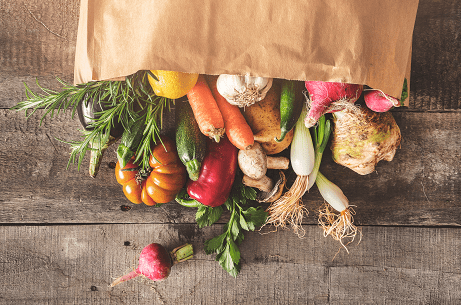When it comes to produce, more is better
Every day, aim for 2 cups of fresh, frozen or no-added-sugar canned fruit. Limit juice to ½ cup a day (you’re better off eating your fruit than drinking it). Here are some tips:
- Add fruit to your breakfast cereal, low-fat yogurt or low-fat cottage cheese (try bananas, raisins, berries, peaches or mangos).
- Add fruit to your salad (try grapes, strawberries, mandarin oranges, sliced apples or pears). Add raisins or pineapple to carrot salad, or try chopped pears in coleslaw.
- Bake apples, pears or peaches with a dusting of cinnamon and brown sugar or honey.
- Puree berries, apples, peaches or pears into a thick sweet sauce for grilled poultry, pork, seafood, French toast, whole grain waffles or pancakes.
- Try grilling pineapple, peach halves or mangos.
Aim for 2½ cups of fresh, frozen or no-added-salt canned vegetables every day. Enjoy steamed or raw. Here are some tips:
- Put spinach, romaine or lettuce and cucumber, tomato or onion on sandwiches and burgers. Replace half the meat or cheese with vegetables. Use hummus or avocado in place of mayonnaise.
- Fill half your plate with vegetables or add a salad.
- Skewer and grill vegetables to make kabobs.
- Microwave frozen vegetables for a quick side dish.
- Add onions, peppers, mushrooms, broccoli or salsa to your eggs or omelet.
- Try steamed cauliflower rice or mashed cauliflower.
- Have vegetable or bean soup for lunch.
- Rainbow peppers or sugar snap peas are great with hummus or low-fat dip.
- Pack raw vegetables or a salad with your lunch (try sugar snap peas, grape tomatoes, baby carrots, rainbow peppers or cucumbers).

Content from General Links with modal content
